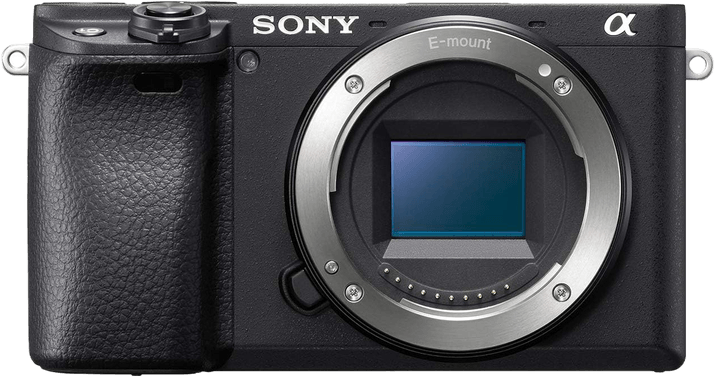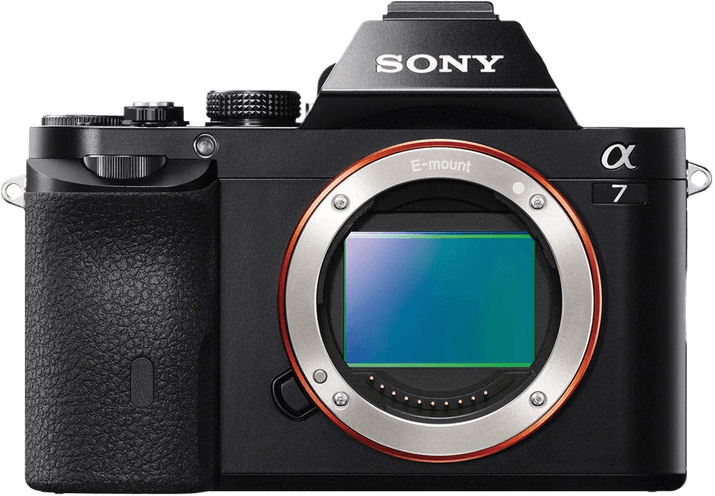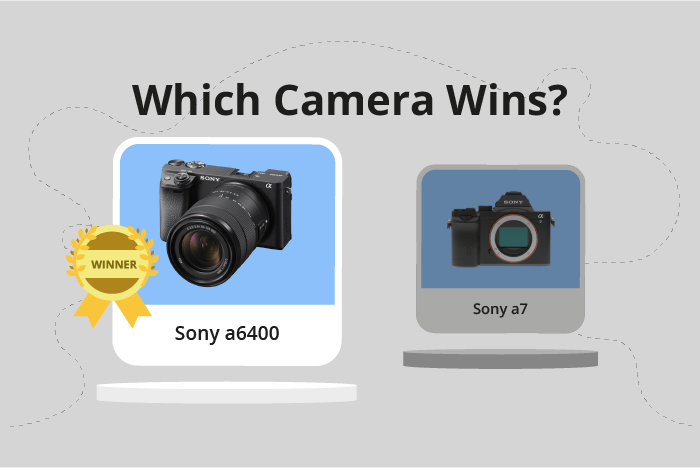Sony a6400 vs a7 Comparison
Sony a6400

Sony a7

The Sony a6400 outperforms the Sony a7 with a score of 70/100 compared to the a7’s 63/100. Both cameras are mirrorless and share some common specifications. The a6400, released in 2019, is lighter (403g) and smaller (120 x 67 x 60mm), making it more portable than the a7, which was released in 2013 and weighs 474g with dimensions of 127 x 94 x 48mm. The a6400 also has a significantly lower launch price of $900 compared to the a7’s $1700.
Despite its lower score, the Sony a7 still offers great performance. However, its higher price and larger size may be drawbacks for some users. The Sony a6400’s higher score, compact design, and lower price make it the better choice for most photographers.
Sony a6400 vs a7 Overview and Optics
The Sony a7 outperforms the Sony a6400 in optics with a score of 70/100 compared to the a6400’s 68/100. Both cameras share several specifications, including a CMOS sensor, Bionz X processor, Sony E lens mount, and lack of image stabilization. However, the differences between these cameras reveal their strengths and weaknesses in optics.
The Sony a7 excels with its full-frame sensor, which results in a higher DXOMARK score of 90 compared to the a6400’s APS-C sensor with a score of 83. This larger sensor allows the Sony a7 to capture more light and provide better image quality, particularly in low-light situations. Additionally, the a7’s 24-megapixel resolution is only slightly lower than the a6400’s 24.2-megapixel resolution, which means that both cameras provide similar levels of detail in the images they capture.
On the other hand, the Sony a6400 boasts a faster shooting speed of 11 frames per second compared to the a7’s 5 frames per second. This makes the a6400 more suitable for capturing fast-moving subjects, such as sports or wildlife photography.
In terms of optics, the Sony a7 is the superior camera due to its full-frame sensor and higher DXOMARK score. This advantage allows for better image quality, especially in low-light conditions. However, the a6400’s faster shooting speed may be advantageous for photographers who prioritize capturing action shots. Both cameras offer high-resolution images and share the same lens mount, providing flexibility in lens options for photographers. Ultimately, the choice between these two cameras will depend on the specific needs and priorities of the user.
Sony a6400 vs a7 Video Performance
The Sony a6400 outperforms the Sony a7 in video capabilities, with a video score of 91/100 compared to the a7’s 56/100. Both cameras share some common specifications, but the a6400 has distinct advantages that contribute to its higher score.
Both cameras can record video, but the a6400 has a maximum video resolution of 4K (3840 x 2160), whereas the a7 only records in Full HD (1920 x 1080). This means the a6400 can capture more detail and produce higher quality footage. The a6400 also has a higher maximum video frame rate of 120fps, double the a7’s 60fps. This allows for smoother slow-motion footage and better handling of fast-moving subjects.
Additionally, the a6400 has time-lapse functionality built in, which is absent in the a7. This feature enables the creation of stunning time-lapse sequences without the need for external software or hardware.
The Sony a7 does not have any specific advantages over the a6400 in terms of video capabilities. Its lower video score is due to its lesser video resolution, frame rate, and lack of time-lapse functionality.
Considering the differences in video capabilities, the Sony a6400 is the clear winner. Its 4K resolution, 120fps frame rate, and built-in time-lapse functionality make it a superior choice for videographers and content creators. The Sony a7, while still a capable camera, falls short in comparison to the a6400’s video performance.
Sony a6400 vs a7 Features and Benefits
The Sony a6400 emerges as the winner in the features comparison, scoring 81/100, while the Sony a7 lags behind with a score of 57/100. Both cameras share some common specifications, including a 3-inch screen size, flip screen, lack of GPS, and WIFI connectivity.
The Sony a6400 surpasses the Sony a7 in several aspects. The a6400 has a touchscreen, which makes it easier for users to navigate through menus and settings. Additionally, the a6400 boasts Bluetooth connectivity, allowing for seamless transfer of files and remote control of the camera. These features contribute to the a6400’s higher score and make it a more user-friendly and versatile camera.
On the other hand, the Sony a7 excels in screen resolution, offering 1,230,000 dots, compared to the a6400’s 921,600 dots. This higher resolution provides sharper and more detailed image previews on the a7’s screen. However, the lack of touchscreen functionality and Bluetooth connectivity on the Sony a7 may outweigh the benefits of its higher screen resolution for some users.
Taking all aspects into consideration, the Sony a6400 proves to be the better camera due to its touchscreen and Bluetooth capabilities. These features provide a more convenient and efficient user experience. While the Sony a7 offers a higher screen resolution, it falls short in other areas, resulting in its lower score. Ultimately, the Sony a6400’s superior features make it the ideal choice for photographers seeking a camera with advanced functionality and ease of use.
Sony a6400 vs a7 Storage and Battery
The Sony a6400 outperforms the Sony a7 in the storage and battery category with a score of 37/100 compared to the a7’s 21/100. Both cameras share some similarities in this aspect, such as having a single memory card slot and accepting SD/SDHC/SDXC memory cards, as well as Memory Stick Duo cards. They also use the same battery type, the NP-FW50.
The a6400 surpasses the a7 in battery life, providing 410 shots per charge, while the a7 only offers 340 shots. Additionally, the a6400 supports USB charging, a feature absent in the a7 model. This advantage allows for more convenient charging options, making the a6400 more practical for extended use.
There are no evident storage or battery advantages for the Sony a7 over the a6400. The a6400’s longer battery life and USB charging capability make it the superior choice in this category. Users seeking a camera with better storage and battery performance should opt for the Sony a6400.
Sony a6400 vs a7 – Our Verdict
Are you still undecided about which camera is right for you? Have a look at these popular comparisons that feature the Sony a6400 or the Sony a7:

